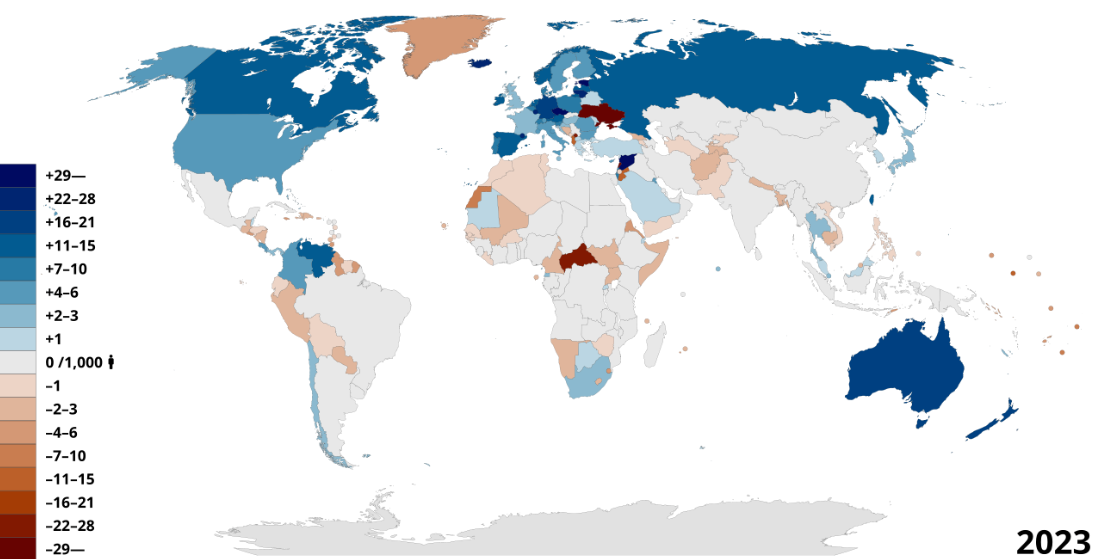Global Migration Patterns: Religious Composition and Economic Impact (GS Paper 1, Society)

Overview
- A recent Pew Research Center report titled ‘The Religious Composition of the World’s Migrants’ offers a comprehensive analysis of global migration trends, highlighting how religion influences migration patterns.
- Based on extensive data from the United Nations and 270 censuses and surveys, the report reveals significant findings about the migration of different religious groups and the economic impacts of diaspora communities.
Key Findings
Hindu Migration Trends:
- Emigration and Immigration: India is both the leading source of Hindu emigrants and the top destination for Hindu immigrants. As of 2020, there were 7.6 million Hindus born in India living abroad, while 3 million Hindus born elsewhere resided in India.
- Global Presence: Hindu migrants make up approximately 5% of the global migrant population, totaling around 13 million. This is a lower representation compared to their 15% share of the world population.
- Travel Distance: Hindu migrants travel further on average—3,100 miles—compared to the global average of 2,200 miles. This is the longest distance among all major religious groups from Asia.
- Destination Regions: The Asia-Pacific region hosts the largest share of Hindu migrants (44%), followed by the Middle East-North Africa (24%), and North America (22%).
Christian Migration Patterns:
- Dominant Group: Christians represent the largest share of the global migrant population at 47%. This high representation underscores the significant role of religion in migration decisions.
Migration Among Indian Religious Minorities:
- Disproportionate Emigration: Indian emigrants are notably disproportionate among religious minorities. Christians make up 16% of Indian emigrants despite being only 2% of India’s population. Muslims represent 33% of Indian-born migrants, while only 15% of India’s population is Muslim.
- Muslim Migration: India is the second-largest source of Muslim migrants globally, with 6 million Muslims primarily settling in UAE, Saudi Arabia, and Oman.
GCC Migration Trends:
- Growth in Migrant Population: The migrant population in GCC countries (Bahrain, Kuwait, Oman, Qatar, Saudi Arabia, UAE) has surged by 277% since 1990. The majority of these migrants are Muslims (75%), while Hindus and Christians make up 11% and 14%, respectively.
Global Migration Trends:
- Overall Increase: From 1990 to 2020, the number of international migrants increased by 83%, greatly outpacing the 47% growth in the global population.
- Average Migration Distance: Migrants, on average, travel 2,200 miles, reflecting a trend of increased global mobility.
Hindu Migration: Detailed Patterns
- Underrepresentation: Hindu migrants are underrepresented globally at 5%, despite their larger share in the world population.
- Long-Distance Migration: Hindu migrants travel the longest distances on average, with significant migration from India, Bangladesh, and Nepal.
- Destination Dynamics: India itself is a major destination for Hindu migrants, particularly due to historical events and regional conflicts.
Economic Impact of Diaspora Communities
Financial Contributions:
- Remittances: Diaspora communities play a crucial role in their home countries by sending substantial remittances. In 2022, migrants from emerging and developing countries sent $430 billion, which far exceeds the financial aid received from international organizations.
GDP Impact:
- Significant Contributions: Remittances constitute a major portion of GDP in several countries. For instance, remittances account for 37% of Tajikistan’s GDP, 30% of Nepal’s GDP, and around 25% in countries like Tonga, Liberia, and Haiti.
Investment and Expertise:
- Diaspora Investments: Diaspora communities often invest in their home countries, contributing to business and economic development.
- Knowledge Transfer: The skills and knowledge gained abroad by diaspora members can enhance productivity and improve business practices in their home countries. For example, Indian executives in the US have facilitated outsourcing to India.
Conclusion
- Migration and the presence of diaspora communities have a profound impact on both origin and destination countries.
- By facilitating substantial financial inflows, investments, and knowledge transfer, these communities drive economic growth and development.
- Governments can maximize these benefits by fostering strong diaspora networks, reducing investment barriers, lowering remittance costs, and supporting diaspora-driven initiatives to ensure sustainable economic progress.


